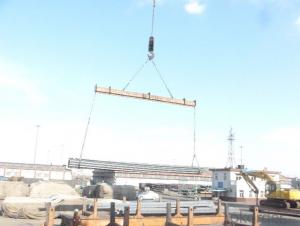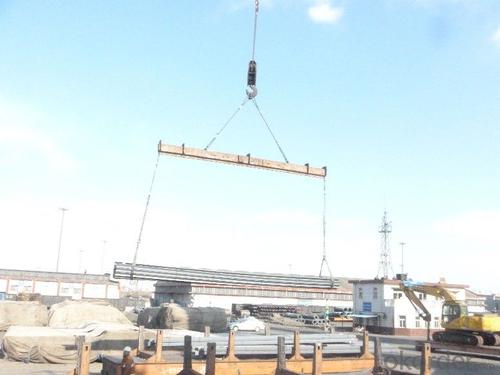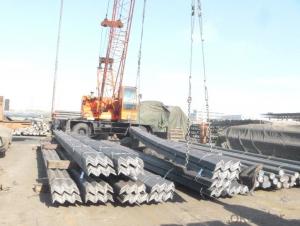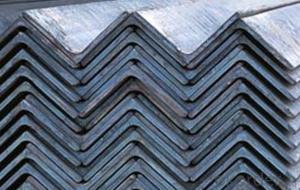hot rolled alloy angle steel
- Loading Port:
- China Main Port
- Payment Terms:
- TT OR LC
- Min Order Qty:
- -
- Supply Capability:
- -
OKorder Service Pledge
OKorder Financial Service
You Might Also Like
Product Description:
Product Description:
Specifications of Angle Steel
1. Invoicing on theoretical weight or actual weight as customer request
2. Length: 6m, 9m, 12m as following table
3. Sizes

Sizes: 25mm-250mm | ||
a*t | ||
25*2.5-4.0 | 70*6.0-9.0 | 130*9.0-15 |
30*2.5-6.6 | 75*6.0-9.0 | 140*10-14 |
36*3.0-5.0 | 80*5.0-10 | 150*10-20 |
38*2.3-6.0 | 90*7.0-10 | 160*10-16 |
40*3.0-5.0 | 100*6.0-12 | 175*12-15 |
45*4.0-6.0 | 110*8.0-10 | 180*12-18 |
50*4.0-6.0 | 120*6.0-15 | 200*14-25 |
60*4.0-8.0 | 125*8.0-14 | 250*25 |
5. Payment terms:
1).100% irrevocable L/C at sight.
2).30% T/T prepaid and the balance against the copy of B/L.
3).30% T/T prepaid and the balance against L/C
6.Material details:
Alloy No | Grade | Element (%) | | ||||
C | Mn | S | P | Si | | ||
| | |||||||
|
|
|
|
|
|
| |
Q235 | B | 0.12—0.20 | 0.3—0.7 | ≤0.045 | ≤0.045 | ≤0.3 | |
|
|
|
|
|
|
| |
Alloy No | Grade | Yielding strength point( Mpa) | | ||||
Thickness (mm) | | ||||||
≤16 | >16--40 | >40--60 | >60--100 | | |||
≥ | | ||||||
|
|
|
|
|
| | |
Q235 | B | 235 | 225 | 215 | 205 | | |
Alloy No | Grade | Tensile strength (Mpa) | Elongation after fracture (%) | | |||
Thickness (mm) | | ||||||
| ≤16 | >16--40 | >40--60 | >60--100 | | ||
≥ | | ||||||
|
|
|
|
|
|
| |
Q235 | B | 375--500 | 26 | 25 | 24 | 23 | |
Usage & Applications of Angle Steel
According to the needs of different structures, Angle can compose to different force support component, and also can be the connections between components. It is widely used in various building structures and engineering structures such as roof beams, bridges, transmission towers, hoisting machinery and transport machinery, ships, industrial furnaces, reaction tower, container frame and warehouse etc.
Packaging & Delivery of Angle Steel
1. Packing: it is nude packed in bundles by steel wire rod
2. Bundle weight: not more than 3.5MT for bulk vessel; less than 3 MT for container load
3. Marks:
Color marking: There will be color marking on both end of the bundle for the cargo delivered by bulk vessel. That makes it easily to distinguish at the destination port.
Tag mark: there will be tag mark tied up on the bundles. The information usually including supplier logo and name, product name, made in China, shipping marks and other information request by the customer.
If loading by container the marking is not needed, but we will prepare it as customer request.
Production flow of Angle Steel
Material prepare (billet) —heat up—rough rolling—precision rolling—cooling—packing—storage and transportation
- Q: Can steel angles be used for reinforcing steel structures?
- Yes, steel angles can be used for reinforcing steel structures. Steel angles are commonly employed to add strength and stability to various steel structures, such as buildings, bridges, and towers. They provide additional support and help distribute loads more efficiently, making them a suitable choice for reinforcing steel structures.
- Q: How are steel angles installed or fixed in place?
- Steel angles are commonly used in construction to provide structural support and reinforcement. They are installed or fixed in place using various methods, depending on the specific application and requirements of the project. One common method of installing steel angles is by welding. This involves permanently fusing the angles to the desired location using a welding machine. Welding provides a strong and durable connection, ensuring the angles stay in place even under heavy loads or vibrations. However, welding requires skilled labor and specialized equipment. Another method is bolting. Steel angles can be bolted to the supporting structure using bolts or screws. This method allows for easy installation and removal, making it suitable for situations where adjustments or modifications may be required. Bolting also offers flexibility in terms of repositioning or replacing the angles if needed. In some cases, steel angles are attached to the structure using adhesive bonding. This method involves applying a strong adhesive material between the angle and the supporting surface. Adhesive bonding is particularly useful when welding or bolting is not feasible or desired. However, it is important to ensure that the adhesive used is suitable for the specific application and can withstand the loads and environmental conditions. Additionally, steel angles can be installed using a combination of methods. For example, welding can be used to provide the primary attachment, while bolts or adhesive bonding can be used as secondary supports or reinforcements. It is crucial to consult with structural engineers or professionals to determine the most appropriate method for installing steel angles based on the specific project requirements, load conditions, and local building codes. Proper installation ensures the angles are securely fixed in place, providing the necessary strength and stability to the structure.
- Q: Are steel angles affected by temperature changes?
- Temperature changes have an impact on steel angles. Similar to all substances, steel undergoes expansion upon heating and contraction upon cooling. These alterations in size can result in dimensional variations in steel angles, thereby potentially compromising their structural stability and fit. Therefore, it is crucial to consider the temperature range that steel angles will encounter in their designated use and accommodate these modifications during the design and installation processes. Furthermore, significant fluctuations in temperature can also influence the mechanical characteristics of steel, including strength and ductility. Consequently, it is essential to factor in these aspects when choosing the most suitable steel angle for a particular application.
- Q: How do you connect steel angles to other structural members?
- Bolts are a commonly employed technique for connecting steel angles to other structural members. This entails aligning the angle with the desired position on the member and drilling holes through both the angle and the member. Subsequently, bolts are inserted through the holes and secured with nuts on the opposite side to establish a connection. Another widely used method for connecting steel angles to other structural members is welding. This necessitates heating the ends of the angle and the member to be connected and then fusing them together using a metal filler rod. Welding offers a robust and enduring connection, but it necessitates skilled labor and proper equipment to achieve a successful weld. In certain scenarios, mechanical fasteners such as screws or self-tapping screws can also be used to connect steel angles to other structural members. These fasteners are generally utilized for lighter loads and non-structural applications. When selecting the appropriate method to connect steel angles to other structural members, it is crucial to consider the specific design requirements and load capacities. Consulting with a structural engineer or adhering to the guidelines outlined in the relevant building codes is recommended to ensure secure and efficient connections.
- Q: What are the limitations of using steel angles in certain applications?
- When considering the utilization of steel angles in specific applications, one must take into account several limitations. To begin with, steel angles may not be suitable for applications that necessitate high strength or load-bearing capacities. While steel angles are generally robust and long-lasting, they may not be capable of withstanding exceedingly heavy loads or forces. In such instances, alternative types of structural steel sections, such as I-beams or hollow sections, may be more appropriate. Additionally, steel angles may not be ideal for applications that require precise dimensions or tight tolerances. Due to the manufacturing process, steel angles can exhibit slight variations in size and shape, which may be unacceptable in certain applications. In these circumstances, it may be necessary to utilize custom-made or precision-machined steel components. Moreover, steel angles may possess limitations in terms of corrosion resistance. If the application involves exposure to harsh environments, such as marine or chemical settings, the steel angles may deteriorate over time. In such situations, materials with superior corrosion resistance, such as stainless steel or aluminum, may be more suitable. Lastly, steel angles may not deliver the desired aesthetic appearance in certain applications. Although steel angles are commonly employed in structural and industrial settings, they may not be visually appealing or compatible with architectural or decorative applications. In these cases, alternative materials or finishes may be preferred to achieve the desired aesthetics. In summary, while steel angles offer numerous advantages in terms of strength, versatility, and cost-effectiveness, they do have limitations in certain applications. It is crucial to thoroughly evaluate the specific requirements of the application and consider these limitations before deciding to utilize steel angles.
- Q: What is the minimum radius for a curved steel angle beam?
- The minimum radius for a curved steel angle beam depends on various factors such as the size and thickness of the angle beam, the type of steel used, and the specific application requirements. It is recommended to consult structural engineers or refer to relevant design codes and standards for the specific project to determine the appropriate minimum radius for a curved steel angle beam.
- Q: Can steel angles be drilled or punched for fastening?
- Fastening steel angles is possible through drilling or punching. These angles are commonly utilized in the construction and manufacturing industries due to their structural strength and versatility. To attach steel angles to other materials or join them together, the most common method is to drill or punch holes. Drilling involves the use of a drill bit to create precise holes in steel angles. This method is suitable when the angle needs to be attached to a specific location. The drilling process can be performed manually or with the assistance of drilling machines, depending on the project's scale. On the other hand, punching involves the use of a punch and die set to create holes in steel angles. This method is faster and more efficient, especially when dealing with large quantities of angles. Punching machines can create holes of different sizes and shapes, making it suitable for various fastening requirements. Once the holes are drilled or punched, fastening can be achieved using bolts, screws, or rivets. These fasteners are inserted through the holes and tightened to securely hold the steel angles together or attach them to other materials. The choice of fastening method depends on the specific application and load requirements. To summarize, drilling or punching holes in steel angles is a viable option for fastening. Whether it's attaching steel angles to other materials or joining them together, drilling or punching provides reliable and secure fastening solutions for construction and manufacturing projects.
- Q: How do you calculate the stability of a steel angle column?
- To calculate the stability of a steel angle column, a few key factors need to be considered. Firstly, the slenderness ratio of the column, which is the ratio of its effective length to its least radius of gyration, must be determined. This can be calculated using the formula: Slenderness ratio = (Effective length of column) / (Least radius of gyration) The least radius of gyration can be calculated using the dimensions of the angle section. For a steel angle, the least radius of gyration can be approximated as the average of the two legs of the angle section divided by the square root of 3. Once the slenderness ratio is determined, it is important to check whether the column is long or short. If the slenderness ratio is less than a critical value, typically around 50 for an angle column, it is considered short and the stability is primarily governed by its strength. In this case, the column can be designed based on its capacity to resist axial compression and flexural buckling. However, if the slenderness ratio exceeds the critical value, the column is considered long and its stability is primarily governed by its ability to resist lateral-torsional buckling. In such cases, additional calculations and considerations must be made to ensure the column's stability. For long angle columns, the critical load at which lateral-torsional buckling may occur can be calculated using various formulas and methods, such as the Euler formula, the Perry-Robertson formula, or finite element analysis. These calculations take into account various parameters such as the column's moment of inertia, modulus of elasticity, and the length of the column. It is important to note that stability calculations for steel angle columns can be complex and require expertise in structural engineering. It is recommended to consult with a qualified professional or refer to relevant design codes and standards, such as the American Institute of Steel Construction (AISC) Manual, for accurate and reliable calculations.
- Q: What is the typical corrosion rate of galvanized steel angles?
- The corrosion rate of galvanized steel angles can vary depending on several factors, such as environmental conditions, exposure to corrosive agents, and the quality of the galvanized coating. However, galvanized steel angles are generally recognized for their excellent corrosion resistance properties. The zinc coating on the steel acts as a protective barrier, preventing the underlying steel from contacting corrosive elements like moisture and oxygen. Under normal atmospheric conditions, the corrosion rate of galvanized steel angles is approximately 1-5 microns per year. This rate can be further reduced in less aggressive environments or with the use of additional protective coatings or maintenance practices. Moreover, in dry or non-corrosive environments, galvanized steel angles can exhibit even lower corrosion rates. It should be noted that in more severe or highly corrosive environments, the corrosion rate of galvanized steel angles may accelerate. These environments may include high humidity, exposure to saltwater, acidic or alkaline conditions, or industrial atmospheres with high levels of pollutants. In such cases, it is advisable to seek advice from corrosion engineers or experts to determine the appropriate corrosion protection measures or alternative materials that may be more suitable for the specific application.
- Q: What is the typical hardness of steel angles?
- The typical hardness of steel angles can vary depending on the specific grade and manufacturing process. However, most commonly used steel angles have a hardness ranging between 120 and 280 on the Brinell hardness scale. It is important to note that the hardness of steel angles can be further influenced by factors such as heat treatment, alloy composition, and surface finishing. Therefore, it is recommended to refer to the specifications provided by the manufacturer or consult relevant industry standards to determine the precise hardness of a particular steel angle.
Send your message to us
hot rolled alloy angle steel
- Loading Port:
- China Main Port
- Payment Terms:
- TT OR LC
- Min Order Qty:
- -
- Supply Capability:
- -
OKorder Service Pledge
OKorder Financial Service
Similar products
Hot products
Hot Searches
Related keywords




























